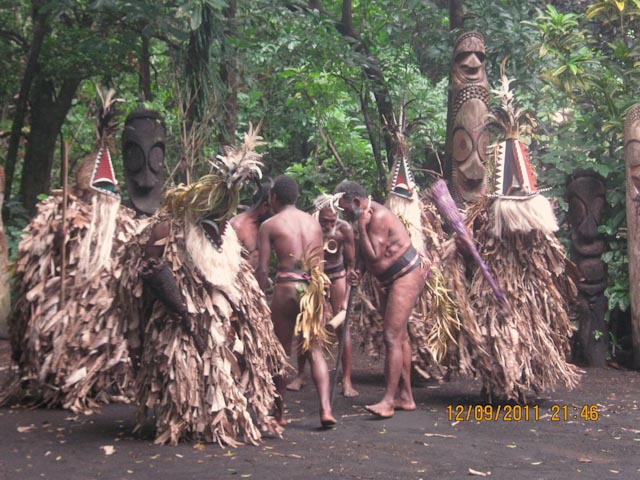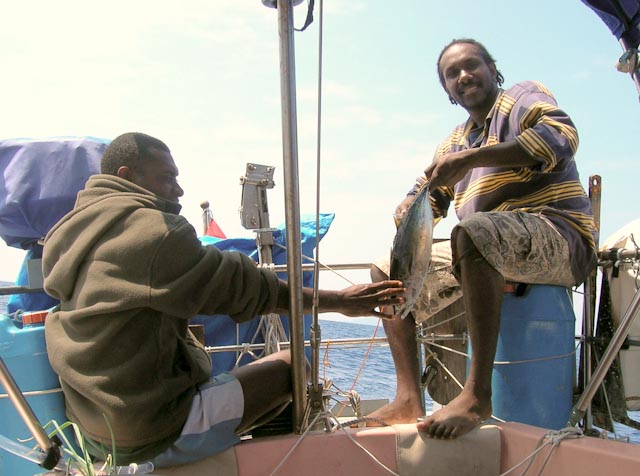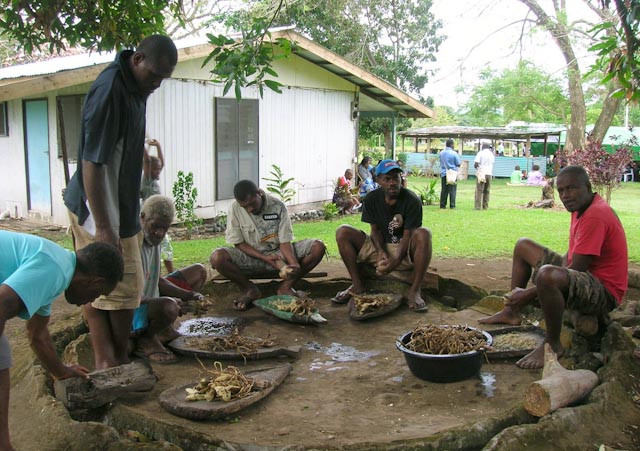From Efate to Tanna
10 to 28 October 2011
The weather (wind) prediction is spot on and on a flat calm sea, we motor through the night to Dillon Bay in Erromango. For a change we have a full moon and combined with a cloudless sky it means that we can see a lot more without the cockpit lighting turned on. If we are lucky, we have the moon till New Caledonia. We do want to sail to New Caledonia and that must certainly be possible, because by going to Erromango, we are now to the east of New Caledonia and to get there the course is west of south. With the prevailing eastsoutheast wind we can sail half wind, a very pleasant sailing angle. It is all going to work out that way, but much later than we planned. By that time the full moon has shrunk to a sliver.
In Dillon bay we are joined by another Dutch yacht, Nije Faem, and together with Paul and Mariëtta we explore the village and the surrounding area. |
Van Efate naar Tanna
10 tot 28 oktober 2011
De weers- (wind-)verwachting krijgt helemaal gelijk en over een spiegelgladde zee moteren we 's nachts naar Dillon Bay in Erromango. We hebben voor de verandering nu eens volle maan en dat gekombineerd met een wolkenloze hemel betekent dat we een hoop meer kunnen zien, zonder de kuipverlichting aan te doen. Met een beetje geluk houden we dit tot Nieuw Caledonië. Wel willen we de rest van de tocht zeilen en dat moet ook kunnen want door eerst naar Erromango te gaan zijn we oostelijk van Nieuw Caledonië gekomen, zodat de koers erheen west van zuid is. Met de heersende oostzuidoostelijke wind is dat halve wind en dat is plezierig om te zeilen. Deze planning gaat uiteindelijk werken, maar wel veel later als dat we denken. Zoveel later, dat als de volle maan allang weer verdwenen is.
In Dillon baai liggen we samen met een ander nederlands jacht, Nije Faem, en samen met Paul en Mariëtta verkennen we het dorpje en de omgeving. |
For us this is our second visit. We were here also seven years ago. The village has become slightly more prosperous (corrugated iron has replaced the traditional palm leaf roofs), but otherwise little has changed. The women still do the laundry in the rocky section of the river and the post office still looks picturesque.
|
Voor ons is dit de tweede keer, we lagen hier zeven jaar geleden ook. Het dorp is iets welvarender geworden (te zien aan de niet traditionele golfplaten daken), maar voor de rest is er weinig veranderd. De was wordt door de vrouwen nog immer in het van vele rotsblokken voorziene deel van de rivier gedaan en het postkantoor ziet er nog steeds pittoresk uit.
|
The river and its surroundings are still as beautiful as in our memories.
|
Ook de rivier en de omgeving zijn nog steeds even fraai als in onze herinnering.
|
Chief William, who seven years ago showed us the burial caves with the remains of the ancestors, has just retired and been succeeded by his son. He had big plans for his village and for the island, but it did not happen yet. What is becoming a reality are David's plans, another villager we met again. When He explained to us seven years ago, that he wanted to build a yacht club, we did not expect that to happen. But he started and there is now a two-storey building of considerable size under construction, surrounded by beautifully landscaped gardens
|
Dorpshoofd William, die ons 7 jaar geleden de knekelgrotten met de resten van de voorvaderen liet zien, is net gepensioneerd en opgevolgd door zijn zoon. Hij had toen grootse plannen voor zijn dorp en voor het eiland, maar die lijken niet helemaal uitgekomen. Wat wel lijkt uit te komen en dat is een verrassing, zijn de plannen van David, een andere dorpsbewoner die we indertijd spraken. Toen verklaarde hij ons, dat hij een jachtklup wilde bouwen en dachten wij op onze beurt, dat daar wel niets van terecht zou komen. Maar zowaar: er staat nu een twee verdiepingen tellend gebouw van behoorlijke afmeting omgeven door fraai vormgegeven tuinen.
|
 |
| The yacht club under construction De toekomstige jacht club |
Let's hope there are many yachts who will visit Erromango and the yacht club in Dillon Bay in the future. It is a good stopover, the bay is fairly protected and comfortable, with good holding in sand, and a nice view at forested hills.
|
Nu maar hopen dat er ook veel jachten gaan komen als de klup helemaal afgebouwd is. En waarom ook niet, de baai is redelijk beschermd en komfortabel, goede zandgrond om te ankeren en een fraaie omgeving om over uit te kijken.
|
I already alluded to the fact that we had some trouble with the next leg of our trip to New Caledonia. We exceeded our record of aborted starts. It stood at two (Madeira, 1991) and now stands at 3.5. That half is a bit peculiar, but will be explained in the next paragraphs.
On October 13 we do our first attempt to sail to New Caledonia. There is wind, that is certain, and the weather maps do suggest that perhaps the wind is too much from the south and maybe too strong. In Dillon Bay there is little wind, so we venture out. Once we inch past the southern cape of Erromango we are hit by 25 knots of wind, but it might be the effect of the cape so we persevere. Indeed, the wind moderates in the lee of Tanna, and the sailing is enjoyable, despite the fact that the wind is from the south. By one 'o clock we sail out of the lee of Tanna. The wind speed increases, the direction remains south, while a current pushes us west. Even sailing clause hauled we can not hold our course. We battle on, but two hours later under deteriorating conditions, we give up, turn around and sail back. The return journey is very quick, soon after sunset the wind increases to 30+ knots and disappears as soon as we round the south cape of Erromango. In the pitch dark we anchor at our old spot in Dillon Bay a very salty Vaarwel (spray). Fortunately, there are no navigational hazards in this bay. On Saturday, 15 October is the second attempt, but it is quickly abandoned. As we leave we pass a sailboat coming from Tanna, whose skipper, when asked, tell us that they had a nice quick run with 25 to 30 knots of wind from the south southeast. Not what we hoped to hear. We round the headland, immediately encountering 25 knots of wind with waves to match and knowing what we know now, we turn around and re-anchor. A journey of no more than 1.5 hours. On 17 October, the wind almost disappears and we decide to either sail to Tanna or Anatom (the two southernmost islands of Vanuatu). Fellow sailors told us, that in the coming days strong southeast winds are forecasted, so it is not a good time to sail all the way to New Caledonia. It is soon apparent that Resolution Bay on Tanna, as well as Anatom, is not feasible. The wind and waves are a bit too strong and too high for our 18 HP engine, we are going too slow. What to do? We decide to turn the bow towards New Caledonia. In the first instance it is going well, our speed is 4 to 5 knots and we even engage our wind vane steering. But at sunset the wind is almost gone and turns south, exactly where we are headed. Grrr!. We struggle on for a few more hours and even turn around, but nothing works. The wind is gone and does not return, just like the waves. The whole crew gets together for a meeting and after consulting an oracle (pilot book), decide to try to motor back to Resolution Bay on Tanna and if that proves impossible, to aim for Black Sand Beach on the west coast of Tanna. At 0900 the anchor is located in the black sands of the bay with that name. |
Ik refereerde al aan het feit dat het vervolg van onze tocht naar Nieuw Caledonië nogal wat voeten in de aarde had. Zelfs zoveel voeten in de aarde, dat we ons rekord aan afgebroken starts verbeteren. Het stond op twee (Madeira, 1991) en het staat nu op 3,5. Die half is een beetje vreemd, maar gaat verklaard worden.
Op 13 oktober doen we onze eerste poging. Er is wind, dat is zeker, maar de weerkaarten doen vermoeden dat de richting wellicht teveel zuid is en misschien is er teveel wind. In Dillon baai is het rustig en dus gaan we. Zodra we onze neus om de zuidkaap van Erromango steken krijgen we 25 knopen om de oren, maar we verwachten dat dat het kaapeffekt is en bijten door. Inderdaad neemt de wind in de lij van Tanna af en wordt het zeilen plezierig, ondanks het feit dat de wind zuidelijker wordt. Om een uur of een 's middags geraken we uit de lij van Tanna. De wind neemt toe, maar blijft te zuidelijk, terwijl we ook door een westgaande stroom weggezet. Zelfs scherp varend kunnen we de koers niet houden. We blijven doorbijten, maar twee uur later onder verslechterende omstandigheden geven we het op, draaien om en zeilen terug. De terugtocht gaat bijzonder snel aangezien de wind na zonsondergang toeneemt tot 30+ knopen en pas wegvalt als we de zuidkaap van Erromango ronden. In het stikdonker ankeren we een flink zoute Vaarwel (buiswater) op onze oude plek in Dillon baai. Gelukkig zijn er geen navigatiegevaren in deze baai. Op zaterdag 15 oktober doen we onze tweede poging, maar die strandt al rap. Bij het wegvaren komt er een zeilboot binnen van Tanna, waarvan de schipper, bij navraag, ons mededeelt dat ze een lekker snelle overtocht hadden met 25 – 30 knopen wind uit het zuidzuidoosten. Niet wat we hoopten te horen. We ronden de kaap, krijgen meteen 25 knopen voor de kiezen met bijpassende golven en wetend wat dat betekent, keren we om en herankeren. Een tocht van niet meer dan 1,5 uur. Op 17 oktober is de wind grotendeels verdwenen en besluiten we naar of Tanna of Anatom te varen (de zuidelijkste twee eilanden van Vanuatu). Van medezeilers vernamen we dat er de komende dagen sterke zuidoostelijke wind verwacht wordt en het dus geen goed moment is om naar Nieuw Caledonië te zeilen. Alras blijkt dat Resolution baai op Tanna, zowel als Anatom, niet haalbaar zijn. De tegenwind en de golven zijn iets te sterk en te hoog voor onze 18 pk motor en dus gaan we gewoon te langzaam. Wat te doen? Dan toch maar de steven gewent richting Nieuw Caledonië. In eerste instantie gaat het goed, halve wind, snelheid 4 à 5 knopen en we zetten zelfs onze windvaan. Echter bij zonsondergang valt de wind bijna weg en draait naar het zuiden, precies waar we heen willen. Baal. We modderen een paar uur door en draaien zelfs om, maar niet helpt. De wind is weg en blijft weg, net als de goven trouwens. De hele bemanning komt bij elkaar voor overleg en er wordt, na het raadplegen van een orakel (pilot boek), besloten om naar Tanna te motoren en Resolution baai nogmaals te proberen en indien dat niet mogelijk blijkt, uit te wijken naar Black Sand Beach (zwart zand strand) aan de westkust. Om 9 uur 's ochtends ligt het anker dus in het zwarte zand van de baai met die naam. |
This was our attempt that counts for half and we also immediately acquired another record: The most times we changed the final destination during a single trip. We are not really very proud of all these records.
At first, he anchorage is not very good. The bay is not really a bay, but a bight (= slight dent in the coastline) with a fair amount of swell and thus rolls the Vaarwel uncomfortably and a sizeable surf breaks on the beach. We keep the dinghy stowed on deck and do not go ashore. The locals do not get many boats in their bay, so they paddle out and visit us in their extra high and seaworthy canoes to satisfy their curiosity. |
Dit was onze halve poging en we hebben ook meteen een ander rekord gezet: de meeste keren dat we van einddoel veranderd zijn tijdens een enkele tocht. Bijzonder trots zijn we niet echt op al deze rekords.
In eerste instantie bevalt de ankerplek niet zo goed. De baai is niet echt een baai, maar meer een bocht (= flauwe deuk in de kustlijn) met een behoorlijke deiningsaktie en dus rolt de Vaarwel onkomfortabel en is de branding op de kust aanzienlijk. We houden de bijboot aan boord en gaan niet aan land. De lokalen, die niet veel boten in hun baai krijgen, zijn best nieuwsgierig en dus komt de wal bij ons langs in extra hoge en zeewaardiger kano's. |
On 21 October after two roly days, we start on our fourth and last of the failed attempts to reach New Caledonia. Based on weather charts, we harbour a faint hope that the wind is from the east and less strong. Hopes are dashed again. After two hours we sail close hauled into 25 to 30 knots of wind, a big swell and breaking waves. Not the right circumstances to expose our old sail wardrobe to. Within five minutes, the crew unanimously decides to turn around.
Back at the anchorage, we notice that the swell and surf are much less. We lower the inflated dinghy in the water and head for the beach. We find the west side of Tanna very interesting. Beautiful rock formations, half in the sea, a freshwater river just behind the black sand beach and more strange rocky platforms at low tide. |
Op 21 oktober na twee dagen rollen, doen we onze vierde en de laatste van de mislukte pogingen om Nieuw Caledonië te bereiken. Op basis van luchtdrukkaarten testen we een flauwe hoop dat de wind wat oostelijker is en wat minder sterk. Niet dus. Na twee uur varen we scherp zeilend, 25 – 30 knopen wind in, met een hoge deining en golven met brekers. Geen omstandigheden waar we onze oude zeilgarderobe aan willen blootstellen. Binnen vijf minuten komt de bemanning unaniem tot de konklusie dat er omgekeerd dient te worden.
Terug op de ankerplek krijgen we een plezierige verrassing, want het rollen is afgenomen evenals de branding op het strand. Bijboot opgepompt en in het water en eenmaal op de kant blijkt deze westzijde van Tanna heel interessant. Fraaie rotsformatie, half in het water, een zoetwater rivier vlak achter het zwarte zandstrand en meer vreemde rotsplateaus bij laag water. |
We pull the dinghy across a narrow strip of sand and row it on the river near the spot where we can collect drinking water (the water comes directly from the hills and mountains, where no one lives). At the end of each day, when the locals go home (there is no settlement in the vicinity), we take a bath in the river and with nobody watching, it does not require swimwear.
|
We trekken de bijboot over de smalle zandstrook en varen het riviertje op tot vlakbij een punt waar we drinkwater kunnen innemen (het water komt direkt uit de heuvels en bergen zetten, waar niemand woont). Aan het eind van elke dag, als de lokalen naar huis zijn (er is geen nederzetting direkt in de buurt) nemen we een bad in de rivier en zonder vreemde ogen in de buurt hebben we daarbij geen zwemkleding nodig.
|
There runs a dirt road parallel to the coast, almost without traffic and thus can we go for walks through a tropical forest with surprisingly mature trees. The loggers have clearly never been here.
We meet Timothy and invite him on-board, and he brings his youngest sons and his grandsons along. |
Er blijkt een onverharde weg parallel aan de kust te lopen, met bijna geen verkeer en dus kunnen we wandelingen maken door een verrassend volwassen tropies bos met flink hoge bomen. De houthakkers zijn hier duidelijk nooit geweest.
We ontmoeten Timothy en nodigen hem aan boord uit, waarbij hij zijn jongste zonen en zijn kleinzonen meebrengt. |
On Wednesday, 26 October, the wind finally turned to the east and blows a pleasant 15 to 20 knots and finally we leave for New Caledonia. Full moon has already long gone: new moon is on 27 October!
|
Op woensdag 26 oktober is de wind eindelijk naar het oosten gedraaid en tot een plezierige snelheid afgenomen (15 – 20 knopen) en vertrekken we definitief naar Nieuw Caledonië. Volle maan is alweer lang verleden tijd: nieuwe maan valt op 27 oktober!
|







































